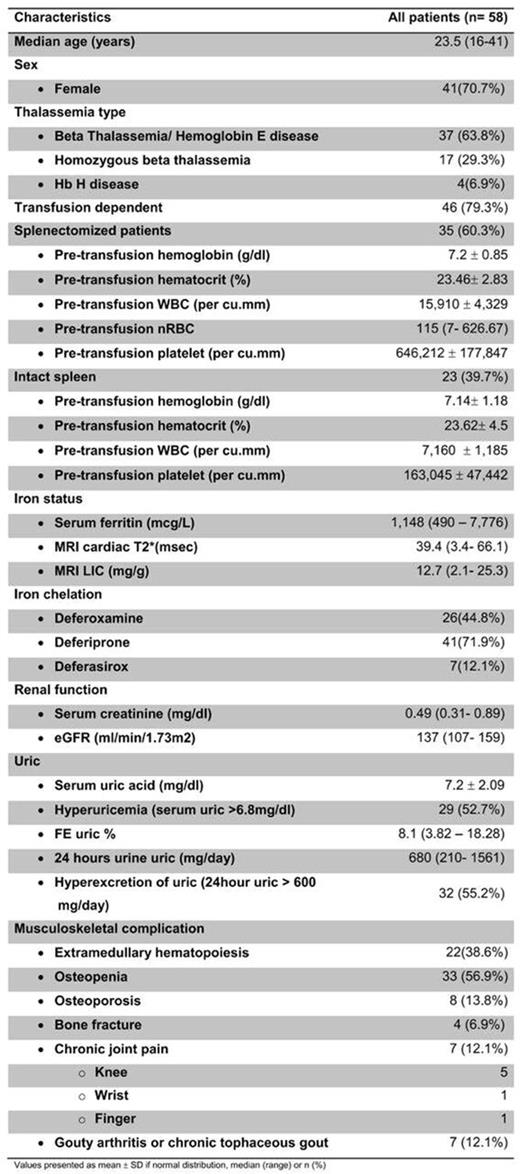Abstract
Background: Thalassemia patients has high cell turnover rate due to its chronic hemolysis and ineffective erythropoiesis, therefore hyperuricemia is anticipated. However, gouty arthritis is not common presentation in this population compared to other diseases which has high cell proliferation and turnover rate. The data about prevalence of hyperuricemia and gouty arthritis in thalassemia patients are also limited. The aim of this study was to identify the prevalence of hyperuricemia , gouty arthritis and associated risk factors in thalassemia patients. We also demonstrated musculoskeletal complications in thalassemia patients.
Methods: This was a cross sectional study in thalassemia patients, age 15 years or older at the Adult Hematology Clinic of the Chiang Mai University Hospital. All patients had serum uric acid and 24 hours urine collection test. Hyperuricemia was defined as serum uric acid more than 6.8 mg/dl. The musculoskeletal investigations were plain film, bone mineral density, MRI spine. The data of history taking, physical examination, blood tests, MRI cardiac T2*, MRI liver for liver iron concentration and echocardiogram were also collected to identify associated risk factors. Categorical variables were compared using the Chi-squared test or Fisher exact test as appropriate. Continuous variables were compared by t-test or Wilcoxon rank-sum test (Mann-Whitney test). Level of significance was defined as p-value < 0.05.
Results: Fifty-eight thalassemia patients were enrolled. The median age was 23.5 (16-41) years. There were 41 female patients (70.7%). Most of patients were beta thalassemia/hemoglobin E disease (63.8%), homozygous beta thalassemia (29.3%) and hemoglobin H disease (6.9%) respectively. Most of them were transfusion dependent (79.3%) and splenectomized patients (60.3%). Hyperuricemia was found in 29 cases (52.7%) with 7 patients who had gouty arthritis (12.1%). Thirty-two patients (55.2%) had hyperexcretion of uric acid (24 hour urine uric excretion > 600 mg/day). The hyperuricemia was significantly identified in patients with intact spleen more than post splenectomy (34% vs.17.6%, OR=14.49, 95%CI: 3.4-62.5, p<0.01). The hyperuricemia patients had significantly lower mean platelet count (325,000 ± 253,000 vs. 602,000 ± 218,000 per cu.mm., 95%CI: 0.98- 0.99, p=0.01), higher mean serum creatinine level (0.62 ± 0.18 vs. 0.49 ± 0.11 mg/dl, 95%CI: 1.89- 2.43, p=0.03) and lower fraction excretion of uric acid (8.2 ± 2.9% vs. 10.86 ± 3.9%, 95%CI: 0.33- 0.82, p<0.01) than thalassemia patients who had normal uric acid level. The association risk factors for hyperuricemia patients who developed gouty arthritis were older age (mean age 42 ± 11.3 vs. 29.8 ± 8.4 years, 95%CI: 34.38- 25.37, p=0.046), lower cardiac T2* (median 36.4 ± 8.6 vs. 40 ± 13.6 msec, IQR: 12.5, p=0.031) and lower eGFR (mean 110.95 ± 2.89 vs. 128.49 ± 11.03 ml/min/1.73m2, 95%CI: 84.90- 137.00, p=0.046) compared to hyperuricemia without gouty arthritis complication patients. In term of musculoskeletal complications, we identified osteopenia in 56.9%, osteoporosis in 13.8%, chronic joint pain in 13.8%, bone fracture in 6.9% and extramedullary hematopoiesis in 38.6% of our thalassemia patients.
Conclusion: Hyperuricemia was found approximately half of thalassemia patients but gouty arthritis was occurred only in ten percent which may be explained by hyperexcretion of uric acid. The significant risk factor were older age, lower eGFR and lower cardiac T2* for gouty arthritis in hyperuricemia patients. Musculoskeletal complications were common in thalassemia patients with more than half of patients had osteopenia.
No relevant conflicts of interest to declare.
Author notes
Asterisk with author names denotes non-ASH members.


This feature is available to Subscribers Only
Sign In or Create an Account Close Modal